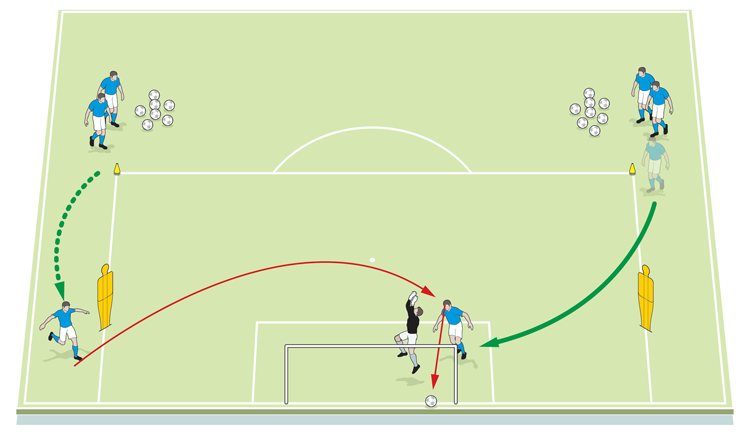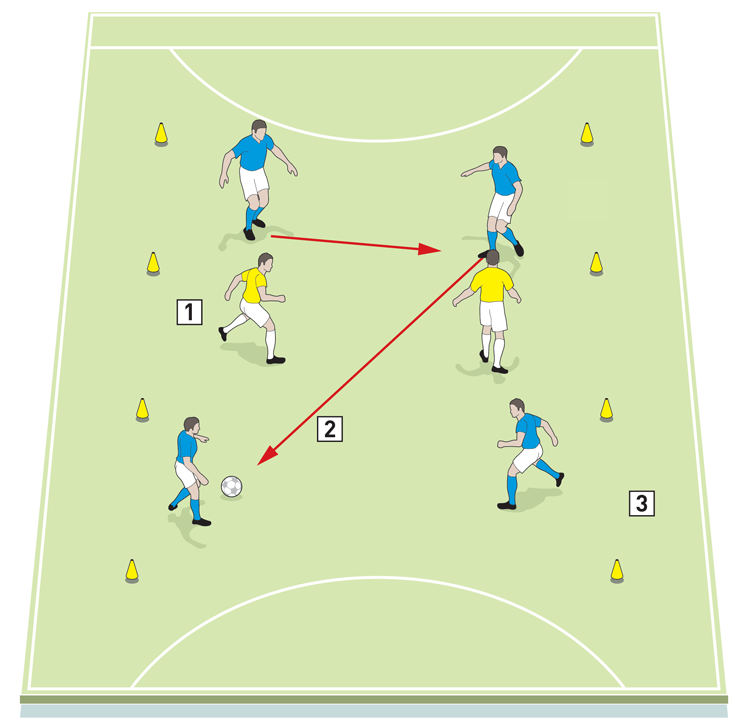




OUR BEST EVER OFFER - SAVE £100/$100
JOIN THE WORLD'S LEADING PROFESSIONAL DEVELOPMENT PROGRAMME
- 12 months membership of Elite Soccer
- Print copy of Elite Player & Coach Development
- Print copy of The Training Ground
You are viewing 1 of your 1 free articles
Attacking centrally
Get your attacking runners playing through the lines centrally, then progress to get players ‘going around the outside’ and pinning the far post with runners in the box.
| Area | Up to a full pitch |
| Equipment | Balls, cones, goals |
| No. of Players | Up to 12 plus keepers |
| Session Time | Warm-up 10mins, Drills 10mins each, Progressions 20mins |
The session is about playing through the lines centrally with attacking runners. It then progresses to seeing players ‘going around the outside’ and pinning the far post with runners in the box.
It is important to practise this, as playing through the lines into the heart of opponents will cause maximum damage, taking multiple players out of the game with a forward pass.
When this attacking tactic is not always possible (should, for instance, teams line up a central block and get bodies behind the ball), having the option to overlap down the outside and deliver in crosses is a great way to combat teams getting bodies behind the ball.
These drills will encourage forward balls and runs into the attacking third and will be performed every couple of weeks, with the option of increasing the frequency depending on match day performances.
What do I get the players to do?
Warm-up
We’ll start with core skill ball warm-ups to rehearse a variety of technical tasks including heading, touches, plus long and short passes in pairs. There doesn’t have to be a regimented structure, but players must get a feel for the ball.
Area one
Next, we split our 12 players into two groups of six. The first group lines up as shown (1). The opposite wide man attacks the far post hoping to score from the resulting cross. The next player in line starts the process again with balls coming in from alternate sides.
Working players always rejoin the group they emerged from.
1

2. A cross is made into the box
3. The winger from the other side makes a run in to ‘pin’ the far post
How do I progress the practice?
We can instruct that only the ‘weaker’ foot can be used when shooting at goal. Alternatively, the crossing player must send the ball in from the by-line, therefore cutting it back to the inrushing striker, or we can add a keeper (2).
2

Area two
In area two the second group practise playing through lines, as shown (3), in a 30x15-yard area. There are six players – two start in the middle with the other four trying to split that central pairing. This encourages forward passing and breaking the lines.
3

2. Attackers must thread a ball through the middle to complete the task
3. The practice then turns and comes back in the other direction
6v6 practice
We now move this into a 6v6 plus two keepers with the focus on possession in the middle third of the pitch (4). Once five passes have been achieved a through ball is played into the final third for runners to move on to unopposed against the keeper.
4

2. The ball is released with a pass through the middle
3. The attacker runs on to score in the goal
This move can then be progressed to an unopposed overlapping run on the outside of the cones (using minimal touches) (5). Once the ball is in wide areas it is important to get bodies in the box, notably with the opposite wide man pinning the far post.
5

2. The ball is worked out to the flanks
3. The winger moves forward using limited touches and crosses
4. Attacking players run in, one of whom ‘pins’ the far post
To progress we can remove one of the defending team to help create an overlap. We play this with one-touch crosses and finishes and can also limit the rest of the play to one- or two-touch, if desired.
What are the key things to look out for?
Crosses need to be game-specific, so precise and measured. When playing through the lines the ball needs to be moved quickly in order to create an ‘out of balance’ effect on opponents. We might also assign a midfielder who can only play forwards to see how he handles the situation.
Keeping the drill’s intensity up is important so we encourage a competitive approach – keeping scores will also stop the players just rolling the ball into the net, and using a keeper to ensure a recognised goalscoring block is a good idea as well.
Related Files
Editor's Picks
Attacking transitions
Deep runs in the final third
Using the goalkeeper in build-up play
Intensive boxes drill with goals
Penetrating the final third
Creating and finishing
My philosophy
Pressing initiation
Compact team movement
Coaches' Testimonials

Alan Pardew

Arsène Wenger

Brendan Rodgers

Carlos Carvalhal

José Mourinho

Jürgen Klopp

Pep Guardiola

Roy Hodgson

Sir Alex Ferguson

Steven Gerrard
Coaches' Testimonials

Gerald Kearney, Downtown Las Vegas Soccer Club

Paul Butler, Florida, USA

Rick Shields, Springboro, USA

Tony Green, Pierrefonds Titans, Quebec, Canada
Join the world's leading coaches and managers and discover for yourself one of the best kept secrets in coaching. No other training tool on the planet is written or read by the calibre of names you’ll find in Elite Soccer.
In a recent survey 92% of subscribers said Elite Soccer makes them more confident, 89% said it makes them a more effective coach and 91% said it makes them more inspired.
Get Monthly Inspiration
All the latest techniques and approaches
Since 2010 Elite Soccer has given subscribers exclusive insight into the training ground practices of the world’s best coaches. Published in partnership with the League Managers Association we have unparalleled access to the leading lights in the English leagues, as well as a host of international managers.
Elite Soccer exclusively features sessions written by the coaches themselves. There are no observed sessions and no sessions “in the style of”, just first-hand advice delivered direct to you from the coach.







